Зоологический журнал, 2019, T. 98, № 5, стр. 504-512
New Taxa of Oribatid Mites (Acari, Oribatida) from the Korup National Park, Cameroon. The Genus Malaconothrus Berlese 1904 (Malaconothridae)
S. G. Ermilov 1, *, J. Starý 2, **
1 Tyumen State University
625003 Tyumen, Russia
2 Czech Academy of Sciences, Institute of Soil Biology
CZ-37005 České Budějovice, Czech Republic
* E-mail: ermilovacari@yandex.ru
** E-mail: jstary@upb.cas.cz
Поступила в редакцию 15.01.2018
После доработки 24.02.2018
Принята к публикации 24.03.2018
Аннотация
Two new species of the oribatid mite genus Malaconothrus (Oribatida, Malaconothridae), both taken from litter and soil in the Korup National Park, Cameroon, are described. Malaconothrus crassilamellaris sp. n. differs from M. rohri Balogh 1997 in the structure and length of notogastral setae e2, h1 and p3. Malaconothrus ciliarostralis sp. n. differs from M. stigmatus Yamamoto et Coetzee 2003 and M. yamamotoi Aoki 1994 in notogastral ornamentation, as well as in the structure of notogastral setae, genital setae g1, g2 and adanal setae ad1.
During the taxonomic identification of oribatid mites (Acari, Oribatida) from the Korup National Park in Cameroon, we found two new species of the family Malaconothridae, both belonging to the genus Malaconothrus Berlese 1904. The primary goal of our paper is to describe and illustrate these new species.
Malaconothrus was proposed by Berlese (1904) with Nothrus monodactylus Michael 1888 as type species. Currently, this genus comprises about 65 species (see Subías, 2004, online version 2017; Colloff, Cameron, 2013 for different classifications). It is characterized by a cosmopolitan distribution. The main generic characteristics of this genus have been summarized by Colloff and Cameron (2013).
This work is part of our study on the oribatid fauna of Cameroon (e.g. Ermilov, Koehler, 2017; Ermilov, Starý, 2018, 2018a).
METHODS
Specimens were mounted in lactic acid on temporary cavity slides for measurement and illustration. The body length was measured in lateral view, from the tip of the rostrum to the posterior edge of the notogaster. Notogastral width refers to the maximum in dorsal aspect. Lengths of body setae were measured in lateral aspect. All body measurements are presented in micrometers. Formulas for leg setation are given in parentheses according to the sequence trochanter–femur–genu–tibia–tarsus (famulus included). Formulas for leg solenidia are given in square brackets according to the sequence genu–tibia–tarsus. Morphological terminology used in this paper follows that of F. Grandjean: see Travé and Vachon (1975) for references, Norton (1977) for leg setal nomenclature, and Norton and Behan–Pelletier (2009), for overview. Drawings were made with a camera lucida using a Leica transmission light microscope Leica DM 2500.
The following abbreviations are used on the figures: ro, le, in, ex – rostral, lamellar, interlamellar and exobothridial setae, respectively; c, la, lm, lp, h, p – notogastral setae; ia, im, ip, ih, ips – notogastral lyrifissures; h, m, a – subcapitular setae; or – adoral setae; l, d, cm, acm, ul, sul, vt, lt – palp setae; cha, chb – cheliceral setae; 1a, 1b, 1c, 2a, 3a, 3b, 3c, 4a, 4b, 4c – epimeral setae; g, ad – genital and adanal setae, respectively; iad – adanal lyrifissure; ω, σ, φ – solenidia; ɛ – leg famulus; v, ev, bv, l, d, ft, tc, p, u, a, s, pv – leg setae; Tr, Fe, Ge, Ti, Ta – trochanter, femur, genu, tibia, tarsus, respectively.
The following abbreviations of collections are used: SMNH – Senckenberg Museum of Natural History, Görlitz, Germany; TSUMZ – Tyumen State University Museum of Zoology, Tyumen, Russia.
SYSTEMATICS
Malaconothrus crassilamellaris Ermilov et Starý sp. n. (Figs 1–3)
Fig. 1.
Malaconothrus crassilamellaris sp. n., adult: a – dorsal view (legs not shown); b – ventral view (gnathosoma and legs except trochanters not shown). Scale bar 100 µm.
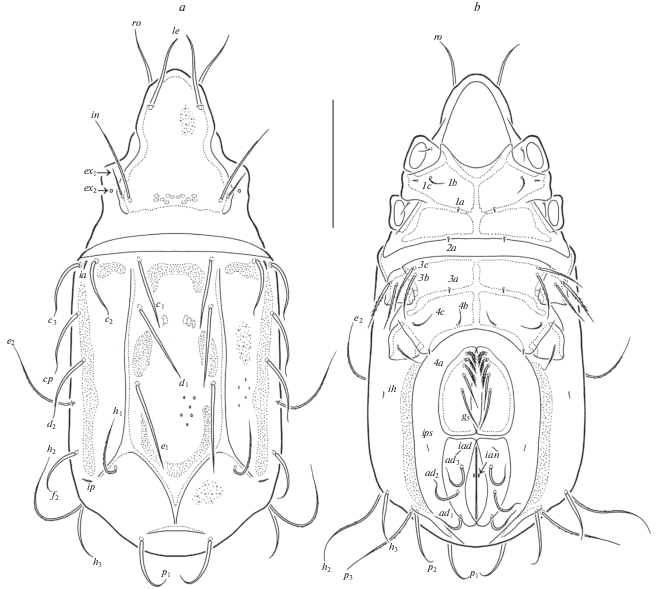
Fig. 2.
Malaconothrus crassilamellaris sp. n., adult: a – lateral view (gnathosoma and legs except basal parts not shown); b – subcapitulum, ventral view; c – palp, right, antiaxial view; d – chelicera, right, antiaxial view. Scale bar (µm): a – 100; b, d – 17; c – 15.
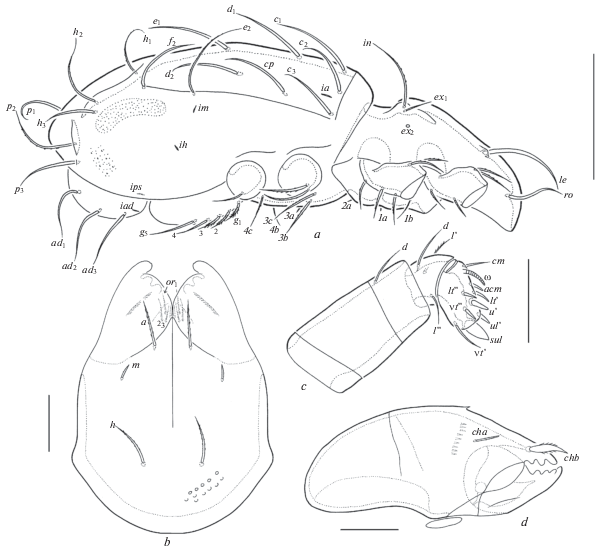
Fig. 3.
Malaconothrus crassilamellaris sp. n., adult: a – leg I, without trochanter, right, antiaxial view; b – trochanter, femur and genu of leg II, right, antiaxial view; c – trochanter, femur and genu of leg III, left, antiaxial view; d – leg IV, left, antiaxial view. Scale bar 17 µm.
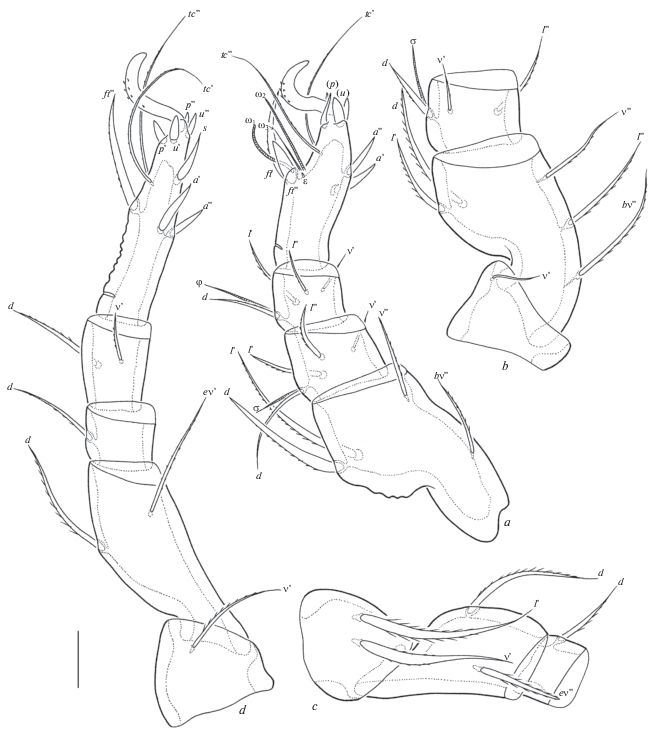
Material. The holotype (♀) and 7 paratypes (7 ♀♀): Cameroon, South-West Province, Korup National Park, Rengo Camp, about 8 km NW of Mundemba, latitude 05°02′11.64″ N, longitude 08°49′45.96″ E, altitude 300 m, litter and soil sifting sample, 12–16.V.2006 (V.V. Grebennikov).
The holotype (ethanol with drop of glycerol) and two paratypes (ethanol with drop of glycerol) are deposited in SMNH; five paratypes (ethanol with drop of glycerol) are deposited in TSUMZ.
Diagnosis. Body size: 381–398 × 166–182. Body surface porose and covered by granular cerotegument, notogaster foveolate. Rostral setae setiform, smooth. Lamellar setae thickened, smooth. Interlamellar setae longest, setiform, barbed. Exobothridial setae ex1 shortest, thin, smooth. Notogastral ridges present. Notogastral setae e2, h1, h2, p3 long, setiform, barbed, other setae shorter, thickened, smooth, p2, p3 located close to each other. Epimeral setae 3b, 3c longest, slightly thickened, barbed. Five pairs of genital setae, g1–g3 heavily ciliated, g4, g5 indistinctly serrated. Anal setae and their alveoli absent. Adanal setae slightly thickened, indistinctly serrated. Legs monodactylous.
Description. Measurements. Body length: 398 (holotype), 381–398 (seven paratypes); notogaster width: 182 (holotype), 166–182 (seven paratypes).
Integument (Figs 1a, 1b; 2a, 2b). Body color light grey to light brown. Body surface densely porose (some porose areas more distinct on the notogaster and forming porose bands) and covered by sparse granular cerotegument (diameter of granules up to 2). Notogaster foveolate, but foveoles (up to 4) clearly visible only under high magnification in dissected specimens.
Prodorsum (Figs 1a, 2a). Rostrum rounded. Lateral carinae well-developed (visible in dorsal view), reaching insertions of rostral setae, translamellar ridge absent between these setae. Rostral setae (41–45) setiform, with short attenuate tips, smooth, directed forwards or dorsolaterally. Lamellar setae (61–65) thickened, smooth, directed forwards. Interlamellar setae (77–82) setiform, barbed. Exobothridial setae ex1 (24–28) setiform, thin, smooth; ex2 represented by alveoli.
Notogaster (Figs 1a, 2a). Anterior margin slightly convex. Posterior part rounded. Notogastral ridges present. Notogastral setae e2, h1, h2, p3 (65–73) setiform, barbed, other setae shorter (53–57), thickened, with short attenuate tips, smooth. Setae p2, p3 located close to each other. Lyrifissures ia located between c2 and c3, ip – posteromedial to f2, im – lateral and close to e2, ih – on lateral parts of notogaster.
Gnathosoma (Figs 2b–2d). Subcapitulum is longer than it is wide: 73–82 × 61. Subcapitular setae h and a (14–16) setiform, barbed, m (6) setiform, erect, slightly barbed. Adoral setae (8–10) setiform, thin, smooth. Palps (36–41) with setation 0–0–1–3–9(+ω). Solenidion of tarsi bacilliform. Setae sul broadly phylliform, other setae spiniform or setiform. Postpalpal setae (8–10) setiform, erect, slightly barbed. Chelicerae (73–82) with several teeth dorsoparaxially and two setae, cha (6) setiform, erect, slightly barbed, chb (12) phylliform, shortly ciliated. Trägårdh’s organs not visible.
Epimeral and lateral podosomal regions (Figs 1b, 2a). Epimeral plates fused medially. Epimeral setal formula: 3–1–3–3. Epimeral setae 1a, 1c, 2a, 3a, 4a (4) spiniform, smooth, 4b (16), 1b, 4c (20) setiform, thin, slightly barbed; 3b, 3c (36–41) slightly thickened, barbed.
Anogenital region (Figs 1b, 2a). Five pairs of genital setae present, they slightly thickened, directed backwards; g1–g3 (16–18) heavily ciliated, g4, g5 (32–36) indistinctly serrated. Anal setae and their alveoli absent. Adanal setae (45–53) slightly thickened, with short attenuate tips, indistinctly serrated. Lyrifissures ips, ian and iad distinct. Ovipositor of typical morphology for Malaconothridae (e.g. Ermilov, 2011), elongated (52 × 36), blades (20) shorter than length of distal section (beyond middle fold; 32). Each of the three blades with four erect, smooth setae, ψ1 ≈ τ1 (20) setiform, longer than spiniform ψ2 ≈ τ2 ≈ τ3 ≈ τ4 (6) and six coronal setae (6).
Legs (Figs 3a–3d). Monodactylous, claws barbed on dorsal sides. Formulas of leg setation and solenidia: I (1–4–4–4–11) [1–1–3], II (1–5–3–4–10) [1–1–1], III (2–2–1–2–10) [0–1–0], IV (1–2–1–2–10) [0–0–0]; homology of setae and solenidia indicated in Table 1.
Table 1.
Leg setation and solenidia of Malaconothrus crassilamellaris sp. n. and Malaconothrus ciliarostralis sp. n.
| Leg | Tr | Fe | Ge | Ti | Ta |
|---|---|---|---|---|---|
| I | v' | d, l ', bv'', v'' | dσ, (l), v' | dφ, (l), v' | (ft), (tc), (p), (u), (a), ɛ, ω1, ω2, ω3 |
| II | v' | d, (l), bv'', v'' | dσ, (l) | dφ, (l), v' | (ft), (tc), (p), (u), (a), ω |
| III | l ', v' | d, ev' | d | dφ, v' | (ft), (tc), (p), (u), (a) |
| IV | v' | d, ev' | d | d, v' | ft '', (tc), (p), (u), s, (pv) |
Remarks. In general morphological traits (body of medium size, interlamellar setae distinctly longer than exobothridial setae ex1; notogastral ridges present; lamellar and many notogastral setae thickened; epimeral setae 3b, 3c longer than others; five pairs of genital setae developed; monodactylous legs), the new species is morphologically most similar to Malaconothrus rohri Balogh 1997 from Brazil (see Balogh, 1997). The new species differs in its the notogastral setae e2, h1, p3 setiform being barbed and longer than other setae (versus e2, h1, p3 thickened, smooth, and similar to many other setae in length in M. rohri).
Etymology. The specific name crassilamellaris refers to the thickened lamellar setae in the new species.
Malaconothrus ciliarostralis Ermilov et Starý sp. n. (Figs 4–6)
Fig. 4.
Malaconothrus ciliarostralis sp. n., adult: a – dorsal view (legs not shown); b – ventral view (gnathosoma and legs except trochanters not shown). Scale bar 100 µm.
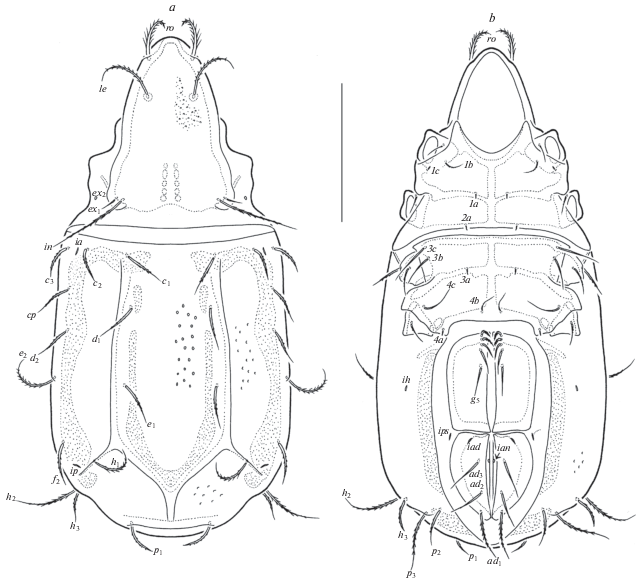
Fig. 5.
Malaconothrus ciliarostralis sp. n., adult: a – lateral view (gnathosoma and legs except basal parts not shown); b – subcapitulum, ventral view; c – palp, right, antiaxial view; d – chelicera, right, antiaxial view. Scale bar (µm): a – 100; b, d – 17; c – 15.
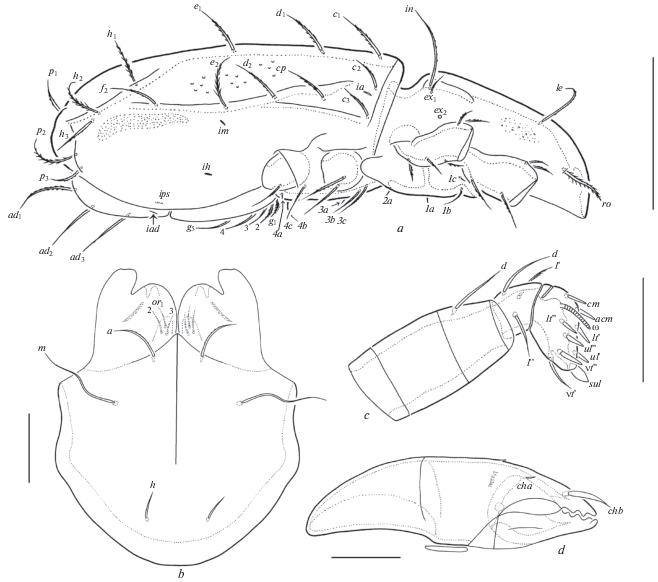
Fig. 6.
Malaconothrus ciliarostralis sp. n., adult: a – leg I, without trochanter, right, antiaxial view; b – trochanter, femur and genu of leg II, left, paraxial view; c – trochanter, femur and genu of leg III, left, antiaxial view; d – leg IV, left, antiaxial view. Scale bar 17 µm.
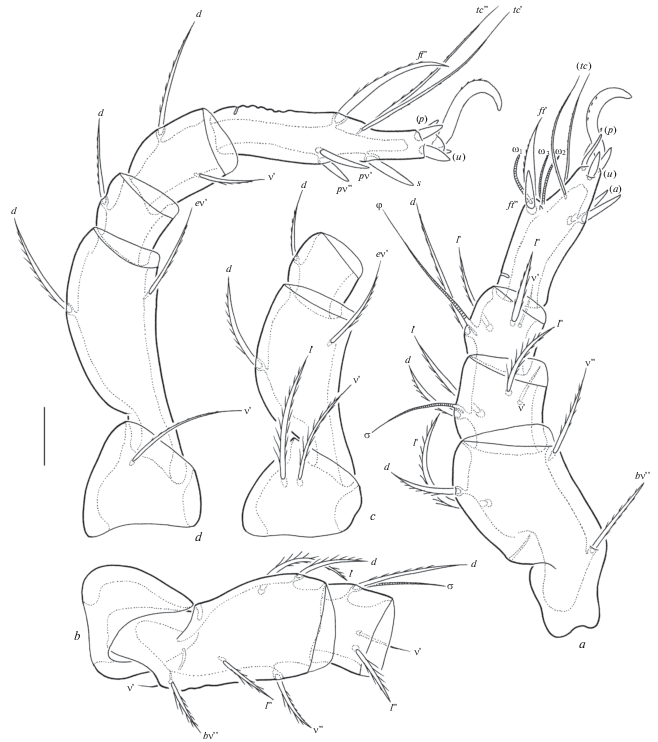
Material. The holotype (♀) and 5 paratypes (5 ♀♀): Cameroon, South-West Province, Korup National Park, Rengo Camp, about 8 km NW of Mundemba, latitude 05°02′11.64″ N, longitude 08°49′45.96″ E, altitude 300 m, litter and soil sifting sample, 12–16.V.2006 (V.V. Grebennikov).
The holotype (ethanol with drop of glycerol) and two paratypes (ethanol with drop of glycerol) are deposited in SMNH; three paratypes (ethanol with drop of glycerol) are deposited in TSUMZ.
Diagnosis. Body size: 348–365 × 156–166. Body surface porose and covered by granular cerotegument, notogaster foveolate. Rostral setae thick, heavily ciliated. Lamellar and interlamellar setae setiform, shortly ciliated. Exobothridial setae ex1 shortest, thin, smooth. Notogastral ridges present. Notogastral setae setiform, shortly ciliated, e2, h1, h2, p3 longer than other setae, p2, p3 located close to each other. Epimeral setae 3b, 3c, 4c longest, smooth. Five pairs of genital setae, g1, g2 heavily ciliated, g4, g5 smooth. Anal setae and their alveoli absent. Adanal setae setiform, ad1 shortly ciliated, ad2, ad3 smooth. Legs monodactylous.
Description. Measurements. Body length: 365 (holotype), 348–365 (five paratypes); notogaster width: 166 (holotype), 156–166 (five paratypes).
Integument (Figs 4a, 4b; 5a). Body color light grey to light brown. Body surface densely porose (some porose areas more distinct and forming porose bands on notogaster) and covered by sparse granular cerotegument (diameter of granules up to 2). Notogaster distinctly foveolate (diameter of foveoles up to 4).
Prodorsum (Figs 4a, 5a). Rostrum rounded. Lateral carinae well-developed (visible in dorsal view), reaching insertions of rostral setae, translamellar ridge absent between these setae. Rostral setae (28–32) thick, heavily ciliated, directed dorsomedially. Lamellar (41–45) and interlamellar (53–61) setae setiform, shortly ciliated. Exobothridial setae ex1 (12–16) setiform, thin, smooth; ex2 represented by alveoli.
Notogaster (Figs 4a, 5a). Anterior margin straight. Posterior part rounded. Notogastral ridges present. Notogastral setae setiform, shortly ciliated, e2, h1, h2, p3 (41–45) longer than other setae (32–36). Setae p2, p3 located close to each other. Lyrifissures ia located between c2 and c3, ip – posteromedial to f2, im – lateral and close to e2, ih – on lateral parts of notogaster.
Gnathosoma (Figs 5b–5d). Subcapitulum longer than wide: 65–69 × 53. Subcapitular setae h (6–8) and m (20–24) setiform, smooth, a (12–14) setiform, slightly barbed. Adoral setae (6–8) setiform, thin, smooth. Palps (36–41) with setation 0–0–1–3–9(+ω). Solenidion of tarsi bacilliform. Setae sul broadly phylliform, other setae spiniform or setiform. Postpalpal setae (6–8) setiform, erect, slightly barbed. Chelicerae (65–69) with several teeth dorsoparaxially and two smooth setae, cha (4) setiform, chb (10–12) phylliform. Trägårdh’s organs not visible.
Epimeral and lateral podosomal regions (Figs 4b, 5a). Epimeral plates fused medially. Epimeral setal formula: 3–1–3–3. Epimeral setae 1a, 1c, 2a, 3a, 4a (4) spiniform, smooth, 1b, 4b (16–20) setiform, thin, slightly barbed; 3b, 3c, 4c (24–28) setiform, smooth.
Anogenital region (Figs 4b, 5a). Five pairs of genital setae present, they slightly thickened, directed backwards; g1, g2 (12–16) heavily ciliated, g3–g5 (20–24) smooth. Anal setae and their alveoli absent. Adanal setae setiform, ad1 (41–49) shortly ciliated, ad2, ad3 (32–41) smooth. Lyrifissures ips, ian and iad distinct. Ovipositor of typical morphology for Malaconothridae (e.g. Ermilov, 2011), elongated (48 × 32), blades (16) shorter than length of distal section (beyond middle fold; 32). Each of the three blades with four erect, smooth setae, ψ1 ≈ τ1 (24) setiform, longer than spiniform ψ2 ≈ τ2 ≈ τ3 ≈ τ4 (8) and six coronal setae (6).
Legs (Figs 6a–3d). Monodactylous, claws barbed on dorsal sides. Formulas of leg setation and solenidia: I (1–4–4–4–11) [1–1–3], II (1–5–3–4–10) [1–1–1], III (2–2–1–2–10) [0–1–0], IV (1–2–1–2–10) [0–0–0]; homology of setae and solenidia indicated in Table 1.
Remarks. In general morphological traits (body of medium size, rostral setae thick and heavily ciliated, interlamellar setae distinctly longer than exobothridial setae ex1; notogastral ridges present; lamellar and many notogastral setae setiform and medium size; five pairs of genital setae developed; monodactylous legs), the new species is morphologically most similar to Malaconothrus stigmatus Yamamoto et Coetzee 2003 from South Africa (see Yamamoto, Coetzee, 2003) and Malaconothrus yamamotoi Aoki 1994 from Japan (see Aoki, 1994). The new species, however, differs from both of the aforementioned species by the notogastral setae, genital setae g1, g2, adanal setae ad1, as well as foveolate notogaster being ciliated (versus the notogastral setae and foveolate notogaster being smooth in M. stigmatus and M. yamamotoi).
Etymology. The specific name ciliarostralis refers to the ciliate rostral setae in the new species.
Список литературы
Aoki J., 1994. New species of oribatid mites from a Moor in Hakone, Central Japan // Proceedings of the Japanese Society of Systematic Zoology. V. 51. P. 35–41.
Balogh P., 1997. New species of oribatids (Acari) from the Neotropical region // Opuscula Zoologica Budapest. V. 29–30. P. 21–30.
Berlese A., 1904. Acari nuovi. Manipulus III // Redia. V. 2. P. 10–32.
Colloff M.J., Cameron S.L., 2013. A phylogenetic analysis and taxonomic revision of the oribatid mite family Malaconothridae (Acari: Oribatida), with new species of Tyrphonothrus and Malaconothrus from Australia // Zootaxa. V. 3681. № 4. P. 301–346.
Ermilov S.G., 2011. Morphology of ovipositors in oribatid mites of the superfamily Crotonioidea (Acari, Oribatida) // Zoologichesky Zhurnal. V. 90. № 10. P. 1168–1174 (in Russian; English version: Entomological Review. V. 90. № 10. P. 1168–1174).
Ermilov S.G., Koehler H.H., 2017. New data on oribatid mites (Acari, Oribatida) of Cameroon: results of the Joint German-Cameroonian scientific expedition (April 2016) // Systematic and Applied Acarology. V. 22. № 12. P. 2233–2244.
Ermilov S.G., Starý J., 2018. Contribution to the knowledge of the oribatid mite genus Cavernocepheus (Acari, Oribatida, Otocepheidae) // Systematic and Applied Acarology. V. 23. № 3. P. 489–500.
Ermilov S.G., Starý J., 2018a. To the knowledge of the genus Gephyrazetes (Acari, Oribatida, Mochlozetidae) // Ecologica Montenegrina. V. 16. P. 34–41.
Norton R.A., 1977. A review of F. Grandjean’s system of leg chaetotaxy in the Oribatei (Acari) and its application to the family Damaeidae // Dindal D.L., ed. Biology of oribatid mites. Syracuse, SUNY College of Environmental Science and Forestry. P. 33–61.
Norton R.A., Behan-Pelletier V.M., 2009. Oribatida // A Manual of Acarology (TX). Lubbock: Texas Tech University Press. P. 430–564.
Subías L.S., 2004. Listado sistemático, sinonímico y biogeográfico de los ácaros oribátidos (Acariformes: Oribatida) del mundo (excepto fósiles) // Graellsia. V. 60 (número extraordinario). P. 3–305. Online version accessed in February 2017. 598 p. http://escalera.bio.ucm.es/usuarios/bba/cont/docs/RO_1.pdf
Travé J., Vachon M., 1975. François Grandjean. 1882–1975 (Notice biographique et bibliographique) // Acarologia. V. 17. № 1. P. 1–19.
Yamamoto Y., Coetzee L., 2003. The Malaconothrus species from South Africa and Lesotho (Acari: Oribatida: Malaconothridae) // Acta Arachnologica. V. 52. № 2. P. 113–126.
Дополнительные материалы отсутствуют.
Инструменты
Зоологический журнал


